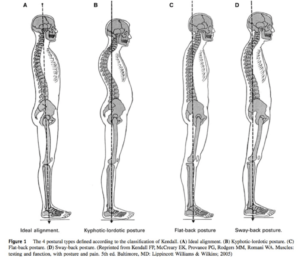What type of posture do you have? Flat back or maybe swayback?
As you probably know, the human spine isn’t completely straight and has a natural S-shaped curve. The curves work like a coiled spring to maintain balance, absorb shock, and allow it movements of the spine. What’s more, back and abdominal muscles maintain the spine’s natural curves. Did you know that your posture can affect not only your spine, but also how you feel? There is a number of different types of posture problems including lordosis (swayback), flatback, kyphosis (hunchback), and forward neck or head. In this article, our spine surgeon in Fort Lauderdale will describe the most common spine curvature disorders and explain how to determine them.
The most common types of poor posture
We mentioned above that healthy posture shape is an S-shape, which keeps your body aligned. In the picture below you can see the Kendell’s Postural Types, including kyphosis, lordosis and flat back syndrome. You can notice how they differ from the healthy, proper posture.
-
Kyphosis
Kyphosis is a common spine dysfunction. It occurs when you stand with your shoulders forward, your head down and your upper back curved. This posture puts a lot of pressure on your back and neck. This will lead to weak muscles in your upper back and abdomen, which can cause back pain and stiffness. Kyphosis can happen at any age. It’s very common in older women after osteoporosis weakens the bones in the spine. But, it is also common in people who spend too much time sitting in front of their computer screens. To avoid hunching over while you are working, you should always remember your posture. Make sure your chair is comfortable and usable and your monitor is at eye level so you don’t have to look down. Strengthening your upper back and your abdominal muscles is recommended as well.
2. Lordosis (Swayback)
Swayback is the reverse of hunchback (kyphosis), and it usually causes back pain and discomfort. Additionally, it leads to weak core muscles that don’t assist the upper body in sitting forward and what’s worse, it may affect your ability to move. Sticking out your stomach and buttocks are typical of swayback, alongside moving your shoulders further back and your head forward. Swayback can be caused by several different things, such as kyphosis, osteoporosis, obesity, and pregnancy. Did you know that constantly wearing high heels or sleeping on your stomach can also cause lordosis? Working on strengthening your abdominal muscles can be helpful in this case.
3. Flat Back
In this case, the spine becomes flat because it loses its natural lower back curve. In consequence, the spine becomes imbalanced and the patient may have trouble standing up straight and leaning forward. The flat back syndrome also causes back or leg pain. Symptoms may get worse and progress to the point where the patient feels they lean further and further forward, away from the body and causing trouble in standing upright. The flat back syndrome can be a result of any condition that shortens the front part of the spine, such as: Degenerative Disc Disease, Compression Fractures, Lumbar Post Laminectomy Syndrome (failed back syndrome), and Ankylosing Spondylitis.
If you are not sure what is causing your back pain, what type of condition you are suffering from, or you suspect that your posture isn’t what it should be, schedule an appointment with our spine surgeon in Fort Lauderdale. Our back specialist will evaluate your condition and provide you with an accurate diagnosis.
4. Forward head or neck
Forward head position is also called “text neck”, and it occurs when your neck and head tilt forward placing your head in front of your shoulders. In other words, where your head is extending out past the shoulders. The forward head position is a result of hunching over your phone or computer for prolonged periods of time. Tilting the head forward, as is typically done when viewing, or writing text messages, forces the neck muscles, tendons, and ligaments to strain when holding the head up. This inappropriate posture can cause tension, stiffness, pain in your neck, or shoulders and back.
Remember, your posture has an impact not only on your spine, but also on your function and overall health. If you would like to know more about how you can fix your bad posture, read our article about 3 ways to improve your posture.

Learn more about Fort Lauderdale Spine Surgeon – Matthew Hepler, M.D.
Dr. Matthew Hepler is an experienced spine specialist in Fort Lauderdale and Delray Beach, who offers expert, personalized medical care and state-of-the-art surgical procedures to treat a wide range of spinal conditions. Dr. Hepler is a Board Certified (ABOS) and fellowship trained orthopaedic spine surgeon with more than 17 years of experience. He focuses on complex deformity and treats the full spectrum of spine conditions such as back pain, disc herniation, stenosis, sciatica, scoliosis, kyphosis, spine fracture, and failed back surgery. Dr. Matthew Hepler provides leading expertise with compassionate, individualized care throughout south Florida (Deerfield Beach, Boca Raton, Delray Beach, Boynton Beach, West Palm Beach, Fort Lauderdale). If you would like more information, please contact us.
The material contained on this site is for informational purposes only and DOES NOT CONSTITUTE THE PROVIDING OF MEDICAL ADVICE, and is not intended to be a substitute for independent professional medical judgment, advice, diagnosis, or treatment. Always seek the advice of your physician or other qualified healthcare provider with any questions or concerns you may have regarding your health.



